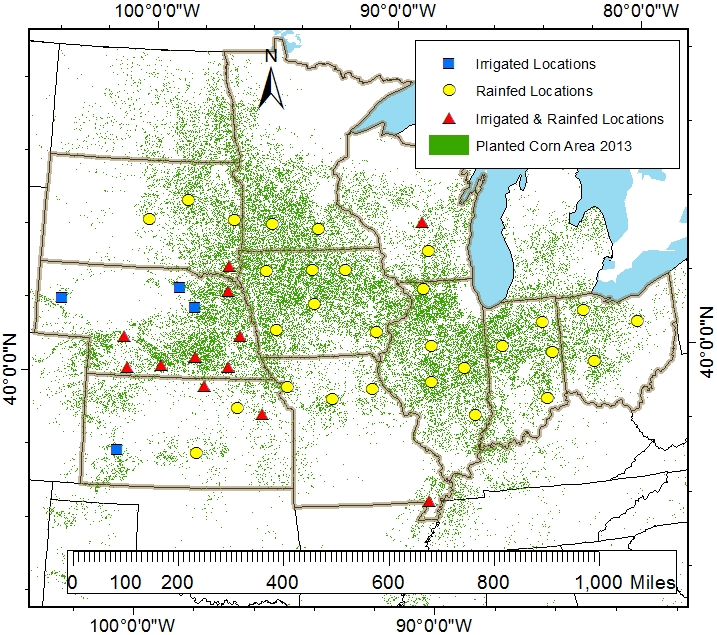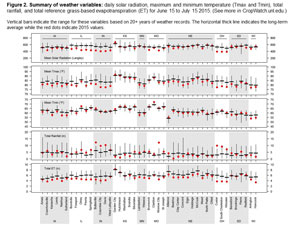2015 Forecasted Corn Yields Based on July 15 Hybrid Maize Model Simulations
July 17, 2015
Corn is approaching silking throughout most of Nebraska and the Corn Belt. The season started with favorable conditions for crop growth (low temperatures and abundant rainfall), but the past week has exhibited relatively warmer temperatures with little (if any) rainfall in many locations. To evaluate, in "real-time," the impact of this season's weather on corn yield potential and its spatial variability across the Corn Belt, simulations of 2015 end-of-season corn yield potential were performed on July 15 for 45 locations (Figure 1). These were made with the UNL Hybrid-Maize model in collaboration with faculty and extension educators from 10 universities. Details about Hybrid-Maize and the underpinning methodology to forecast end-of-season yields, as well as information on interpretation and uses of yield forecasts, can be found in a previous CropWatch article.

Figure 1. Locations used to simulate 2015 forecasted corn yields using Hybrid Maize.
See corn yield projections, as of July 15, for these sites in Tables 3-5.
Briefly, the Hybrid-Maize model simulates daily corn growth and development and final grain yield under irrigated and dryland conditions. The model estimates "yield potential" — yield that could be obtained if the crop were not limited by nutrient supply, diseases, insect pressure, or weed competition, conditions representative of an optimal management scenario. It also assumes a uniform plant stand at the specified plant population, and no problems from flooding or hail. Because weather, soil, and management factors are location-specific, Hybrid-Maize simulations are based on actual weather data, soil, and typical management practices at the location being simulated as provided by agronomists, extension educators, and DuPont Pioneer agronomists in each state. (See Tables 1-2.)
Irrigated and dryland yield forecasts as of July 15 are shown in Tables 3-5. (Table 3 features Nebraska sites.) Though the range of forecasted irrigated yields is wide and includes the long-term average at all irrigated sites, there is already a high (>80%) probability of near- or above-average irrigated yields at most locations in Nebraska (7 of 10 sites) due to mild daytime temperatures. However, it is still too early in the growing season to tell if forecasted yields will remain around the long-term mean or move above. The scenario is more uncertain for the other irrigated sites in SD, MO, KS, and WI, where probabilities (of below-, near-, and above-average yields) are quite similar (SD, MO, and WI) or vary greatly across locations (KS).
For dryland yields, the yield scenarios look favorable, especially for the central and eastern Corn Belt. There is a high probability of near- or above-average yield (>80%) at 28 of the 41 dryland sites. Indeed, at eight sites, there is already a high probability of above-average dryland yields (>66%). The scenario is less clear across the rainfed sites in the western Corn Belt (NE, KS, SD), with three sites with a high probability of above-average yields, three sites with likely below-average yields, and the rest of the sites with similar probabilities of below-, near-, and above-average yields. The range of dryland yield forecasts is wide, hence, these early forecasts should be taken with caution.

A summary of the weather conditions (daily solar radiation, maximum and minimum temperature, total rainfall, and total (grass-based) reference evapotranspiration [ET]) for the time period between June 15 and July 15 is presented in Figure 2 to help interpret the simulated yields. In Figure 2, vertical bars indicate the range for these variables based on 20+ years of weather records. The horizontal thick line indicates the long-term average while the red dots indicate the 2015 averages.
At most sites, rainfall has been near normal during the last 30 days (June 15 through July 15), but in the eastern Corn Belt (IL, IN, and OH) above-normal rainfall and lower solar radiation occurred during this period. Daytime temperatures have been consistently below normal throughout the Corn Belt (despite increasing significantly during the past week), with nighttime temperatures remaining near normal. In addition, reference ET has remained consistently below normal throughout the region as a consequence of low daytime temperatures and solar radiation.
Conclusions
Although the range of forecasted yields is still wide, growing conditions up to now look favorable for dryland corn, especially in the central and eastern Corn Belt. Probability of above- or near-average irrigated yields in Nebraska are high. These forecasts do not take into consideration problems with stand emergence due to residue, hail/flooding damage, replanting situations, disease, or nitrate leaching. In fields negatively affected by these constraints actual yields will be lower than estimates provided here. We will follow up with further forecasts in late July/early August.
Francisco Morell, UNL Post-doctoral Research Associate
Patricio Grassini, UNL Assistant Professor of Agronomy and Horticulture, Extension Cropping System Specialist and Water for Food Institute Fellow
Haishun Yang, UNL Associate Professor of Agronomy and Horticulture and Water for Food Institute Fellow
Kenneth Cassman, UNL Professor of Agronomy and Horticulture and Robert B. Daugherty Water for Food Institute Fellow
Roger Elmore, UNL Professor of Agronomy and Horticulture, Extension Cropping System Specialist and Water for Food Institute Fellow
Justin Van Wart, UNL Post-doctoral Research Associate
Keith Glewen, Nebraska Extension Educator
Jennifer Rees, Nebraska Extension Educator
Greg Kruger, UNL Assistant Professor of Agronomy and Horticulture and UNL Extension Cropping System Specialist
Charles Shapiro, UNL Extension Soils Scientist – Crop Nutrition and Professor of Agronomy and Horticulture
Ignacio Ciampitti, Crop Production and Cropping System Specialist and Assistant Professor of Agronomy, Kansas State University
Mark Licht, Extension Cropping System Agronomist, Iowa State University
Peter Thomison, Extension Specialist and Professor, Ohio State University
Joe Lauer, Professor, University of Wisconsin-Madison
Sylvie Brouder & Tony Vyn, Professors of Agronomy, Purdue University
Ray Massey, Extension Professor, University of Missouri
Cameron Pittelkow, Assistant Professor, University of Illinois
Chris Graham, Assistant Professor, South Dakota State University
Jeff Coulter, Associate Professor and Extension Specialist, University of Minnesota
Online Master of Science in Agronomy
With a focus on industry applications and research, the online program is designed with maximum flexibility for today's working professionals.
